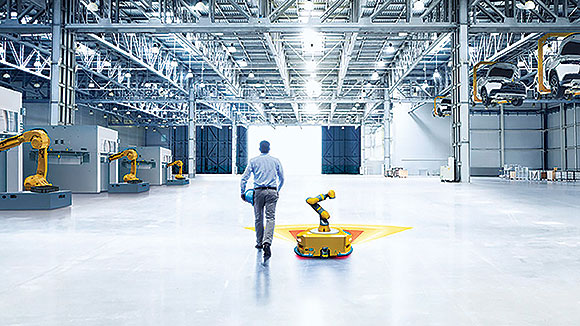

The ongoing development of small, powerful and flexibly positionable robots that can collaborate with humans is progressing in leaps and bounds. Sensors from SICK Automation are an important component.
Sensor intelligence plays a vital role, not only in orienting and positioning mobile collaborative robots (cobots), but also in reliably monitoring their surroundings. Lightweight cobots that are transported to their working position on automated guided vehicles and autonomously position themselves are the newest development in this area. These cobots are making fence-free and flexible work an increasingly standard feature in robotics and a new foundation for functional automation.
Smaller and more flexible systems now make industrial robot applications suitable for a wider variety of applications. Mobile cobots mounted on automated guided vehicle systems and weighing less than 15 kilograms are garnering particular interest. SICK Automation’s complete range of sensor solutions for robots and mobile platforms are being employed in this area: robot vision, safe robotics, end-of-arm tooling, position feedback, environment perception and safety.
Cobots and mobile platforms unite
Cobots are especially suitable for flexible applications that can also be temporarily employed in production lines. They are either permanently integrated into the production line or installed on mobile platforms. This drastically reduces the time required to set up the cobots at their workstation. This is achieved by employing sensor solutions from SICK to move the cobot to its workstation and reliably position it. The cobot is combined with an automated guided vehicle system to create a mobile unit that can autonomously find its safe position. Robot guidance systems such as the PLR from SICK are especially suited for this task.
As they move into position, these mobile platforms with cobots must pose no risk to persons or machines, and sometimes need to travel through narrow passageways in production. Sensor and system solutions from SICK help to reliably protect humans and property from collisions, while at the same time collecting all necessary data for the dependable and flexible navigation of automated guided vehicles. These vehicles manage high speeds even when going around curves thanks to the switching of protective fields.
Collaboration begins in the community
A cobot solution can be implemented efficiently by utilising the so-called Robot Operating System (ROS). This is an open source framework that was developed in a university setting. Thanks to a very active community, it has also found its way into industrial applications around the world. Small and mid-sized companies in particular can benefit from this because it enables them to save on development costs and resources.
Robots without fences, sensors without limits
Cobots generally have a high level of movement flexibility on account of their degrees of freedom. A wide range of sensor solutions are therefore required to protect their entire working space when in use. Laser scanners not only guarantee the reliable positioning of the cobots in the workspace but also protect the workers nearby. This includes monitoring the surroundings using safety laser scanners, which reduce the speed of the cobot when a person approaches. An automated restart after a complete stop that requires no manual intervention from the worker is also part of the solution. Furthermore, the motor feedback systems integrated into the cobot reliably and dependably report the position of the robot arms to the controller. This data enables the entire Cartesian workspace right through to the end-of-arm tooling to be securely monitored.
The last mile firmly in view
Similar to the field of logistics, the field of robotics also uses the concept of the ’last mile’. In robotics, this describes the challenge of ensuring that a deployed robot operates in a safe manner and can be controlled right down to the last millimetre. In particular in the case of precisely calibrated robots working in an open space with no protective fences, meeting this challenge calls for great mastery and sophistication. It is the interplay of a large number of sensors, especially the motor feedback systems, that allows safe and trouble free end-of-arm tooling on the gripper. New solutions at the end of the arm for completely eliminating injuries to worker’s hands will be available soon. These will employ 2D and 3D image-based robot vision solutions, i.e., a type of ‘Cobot Vision’.
| Tel: | +27 10 060 0550 |
| Fax: | 086 598 7915 |
| Email: | [email protected] |
| www: | www.sick.com |
| Articles: | More information and articles about SICK Automation Southern Africa |

© Technews Publishing (Pty) Ltd | All Rights Reserved